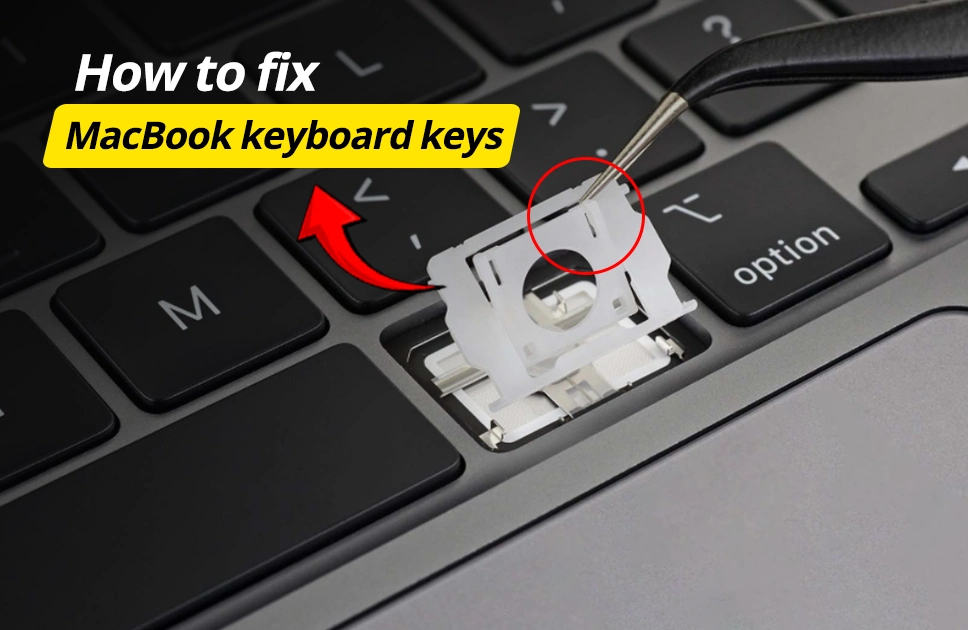Tips and Tricks
How to Fix MacBook Keyboard Keys in Minutes
We’ve all faced this – you’re clacking away at your MacBook, halfway through that research paper or a super important last minute late-night mail; and suddenly that “E” key goes rogue. It’s sticky, stuck or worse – completely unresponsive. Panic sets in as you tap harder, but nothing happens.
MacBook keys are sleek, satisfying, and extremely prone to mischief. Those notorious butterfly keys or the new scissor switch keys – both can get stuck, and there’s always a good story behind a stuck key, such as crumbs from your midnight snacks, or your cat stepping on it with mysterious liquid paws.
However, a sticky, stuck, or unresponsive key doesn’t mean you need a Genius Bar appointment just yet. In this guide, we’ll walk you through how to fix MacBook keyboard keys, what causes the issue, and when it’s time to get expert help. Without further ado, let’s get started with what things can cause MacBook keyboard keys to stop working.
Why MacBook Keyboard Keys Stop Working
Understanding how to fix MacBook keyboard keys starts with knowing what causes them to act up in the first place. Here are the most common culprits:
The most common culprit is dust and debris, which can easily slip under your MacBook keys, causing sticky MacBook keys. Liquid spills are also prominent in this, gumming up the mechanism left by the residue. Some older MacBooks built with the “butterfly mechanism” are notoriously prone to wear and malfunction. While all these physical reasons may lead to an unresponsive MacBook keyboard, sometimes it’s not the hardware at all – a misconfigured accessibility settings or system glitches can silently sabotage your typing.
Start Here: Quick Checks Before You Tinker
Before you dive deep into fixing your MacBook keyboard keys, try these simple steps, as most of the times the solution is just a few clicks way –
- Restart Your MacBook – Restarting the MacBook is a classic tip because it works. A quick reboot often clears the minor glitches by resetting the system process that might be causing an unresponsive keyboard.
- Try Safe Mode or Guest User – Boot into Safe Mode (hold Shift at Startup) or switch to a Guest User. Provided that the keyboard works there fine, the issue is most likely tied to the user settings or software.
- Update macOS – Hardware can behave weird due to a system with an outdated OS. Navigate to System Settings → General → Software Update and proceed to install any available updates.
- Use Keyboard Viewer – Go to System Settings → Keyboard → Input Sources → Show Keyboard Viewer. Tap and see if each key is registered, it’s a quick solution to recognize faulty keys.
How to Fix MacBook Keyboard Keys at Home
Now that we’ve covered some basic fixes, let’s look at these steps to DIY fix your macBook keyboard keys. These methods are safe, beginner friendly and often all you need to get your keys clicking again – no tech degrees needed.
Clean the Keyboard with Compressed Air
Dust and debris are often the silent troublemakers, lodging under your keycaps and causing sticky key issues. Here are the Apple recommended steps to clean them –
- First, power off your MacBook and unplug it.
- Flip the Mac laptop at a bottom side up position
- Hold it at a 75 degree angle (almost vertical)
- Using a straw nozzle, blow air from a compressed air can
- Spray in short burst, moving left to right
- Rotate and repeat with all sides
Note: Do not directly blow air under the keycaps, it can cause damage. You can spread a cloth or towel under the Mac as you do this, so the station remains clean. Also, see that the compressed air does not come out as near frozen liquid, which can lead to short circuits.
Spot-Clean with Isopropyl Alcohol
99.9% isopropyl alcohol is ideal to clean sticky keys caused by spills or residue, such as a kitchen counter mishap or coffee spill on a casual movie-munching session. Here’s what to do –
- Get 99.9% isopropyl alcohol and a cotton swab.
- Don’t completely soak, but lightly dampen the Q-tip.
- Gently clean around the sticky key, try reaching under as much as you can – don’t force.
- Press the specific key repeatedly, so gunks get loose.
- Let the keyboard completely dry before powering your MacBook back.
Remove & Reattach Keycaps (Scissor-switch only)
Post 2020 MacBook models come with a scissor-switch mechanism, and their keycaps are easy to replace / remove and clean. Attempt this method only if you’re confident and using a compatible model of MacBook –
- Use a flat tool (i.e – a spudger) and gently pop off the keycap. You will also find dedicated keycap pullers in the market, which are the safest to use in this case.
- Clean the exposed area with isopropyl alcohol or compressed air. Be careful with this step because this is risky.
- Realign the keycap and press down until it clicks to position.
- Test if the key functions right away.
Check Your macOS Keyboard Settings
If the aforementioned methods didn’t turn into a success, chances are the problem isn’t hardware but a few hidden settings that mess with how your keyboard responds.
Turn Off “Slow Keys” and “Mouse Keys”
“Slow Keys” and “Mouse Keys” functionality can make your MacBook keyboard delayed in response. This is usually turned on by default on MacBooks to avoid registering a keypress that was accidentally pressed by the user, such as the Caps Lock button. A mismatched keyboard layout with Slow Keys or Mouse keys enabled will lead to delay or altercation on how your keyboard behaves. This is how to turn off Slow Keys and Mouse Keys –
- Click the Apple icon in the top left corner on your screen.
- Navigate to System Preferences → Accessibility.
- Find “Keyboards” from the left menu and see if “Slow Keys” is enabled.
- Toggle to turn it off.
- Scroll to “Pointer Control” and ensure “Mouse Keys” is turned off.
- Test your keyboard again to see if it functions normally.
Reset SMC and NVRAM
Resetting SMC (System Management Controller) and NVRAM/PRAM can often fix system glitches. These two low-level controller resets is an effective way to get your MacBook keyboard up and running again without much hassle. Here are the steps –
For MacBooks with Apple Silicon
Simply shut down your MacBook and then turn it back on – this will automatically reset the SMC/NVRAM.
For Intel-based MacBooks
Resetting SMC:
- Shut down by going to the Apple menu > Shut Down.
- Press and hold Shift + Control + Option + Power Button simultaneously.
- Press and hold all the four keys for 10 seconds.
- Power on the device normally.
Resetting NVRAM/PRAM:
- Go to Apple Menu > Shut Down and turn off your MacBook.
- Press the Power Button to power on the MacBook.
- Immediately press and hold Option + Command + P + R.
- Hold until the startup sound rings twice (or the Apple logo appears and disappears twice on MacBooks without a startup sound).
- Release and let your MacBook boot up normally.
Still Not Working? Time to Consider Professional Repair
If you’ve tried all the steps mentioned above and your keyboard is still sticky, stuck or skipping – don’t stress. Some issues go beyond DIY, and this is where trusted, professional hands come in.
Choose Apple Gadgets Care Over the Genius Bar
Time to forget long queues. Apple gadgets care is Bangladesh’s leading pro service center – not just for MacBooks but every gadget you care about. From smartphones to notebooks and niche gadgets, we’ve fixed them all.
Our expert technicians bring 12 to 20 years of hands on experience to deliver a hassle free repair without any hidden charge. Unsure if your device needs a professional look? Call us for a free consultation over the phone, so you can troubleshoot your favorite gadget from the comfort of home.
And if your device needs to visit us, we can also arrange pickup and delivery via courier, saving both your time and money. We are a group of professionals with personal care. So visit resort to Apple gadgets Care to fix your MacBook keyboard keys in no time!
Bonus: How to Prevent Keyboard Problems in the Future
Knowing how to fix MacBook keyboard keys is great. But preventing issues in the first place is even better. A few simple habits can take you a long way –
Clean your valuable MacBook keyboard with compressed air every few weeks to keep dust and debris out of the way. Avoid snacking near the Apple laptop and prevent accidental crumbs and spills. Also, there are top tier silicone keyboard covers that will offer an extra layer of protection. For long sessions of typing, consider using an external keyboard so your inbuilt keyboard remains minty fresh over the years.
Final Thoughts
With a little patience and the right tools in hand, sticky, unresponsive, or ones with weird glitches – every MacBook keyboard can be repaired. Simple habits like cleaning with compressed air, isopropyl alcohol and tweaking accessibility settings will take you a long way in a smooth journey of typing with your MacBook keyboard.
Now, If you’ve come this far, you’re a champ: a DIY warrior who deserves a cookie! If you want to keep your MacBook, iPhone, laptop, smartwatch, or earbuds in tip-top shape – whether it’s MacBook battery care, overheating iPhone fixes, fixing iPhone Camera or rescuing a water-damaged iPhone, Apple Gadgets Care Blog has your back. It’s your go-to for expert guidance, free consultations, and real human support.
Till next time, take great care, and we promise we’ll meet again in another blog, deep in the satisfying world of tech solutions.

Ifrad Mahbub is a tech enthusiast with more than two years of experience in writing about cutting-edge smart gadgets, cameras, and computers. He is passionate about exploring new technologies and engaging with like-minded professionals on the future of digital trends.

